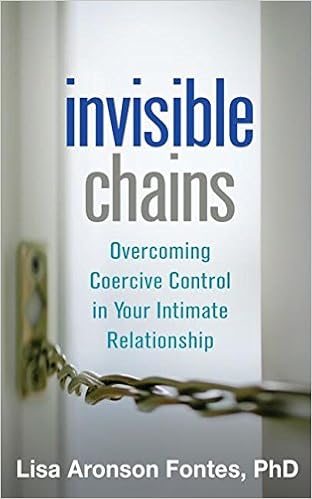Recently, I was confronted by an acquaintance of mine over some family trouble one of his children was having. One of the things he said to me was that people talking about it were "contributing to the abuse" of his child. When I asked for his definition of abuse, he didn't provide one, but pointed me toward the book Invisible Chains: Overcoming Coercive Control in Your Intimate Relationships by Dr. Lisa Aronson Fontes, PhD. He said someone had labelled the type of abuse that his child was suffering from "coercive control"and that this was the book this person had used.
So I read it. Not to disprove or argue with anyone, but because I wanted a healthy mental state and a God-honoring marriage for his child, and up to this point, there were some things I'd seen and read from both him and his child that I found troubling. If the book was a solid piece of work, so much the better.
This isn't intended to be a comprehensive review. It's mainly my thoughts on its topic, how it addresses that topic, and specifically, my thoughts about what value it might have for anyone having difficulties within their marriage.
I'll start with a few caveats.
- When I heard the term "coercive control" I thought of it being the use of various tactics (mental, physical, emotional) to manipulate one's partner into behaving how one wished. I'd agree that this is a bad thing; it shows a lack of respect (at a minimum) for one's partner.
- This post isn't about a specific person or relationship. It's about the book and how I think it would be used.
- I'm not trained in therapy and I haven't even done extensive personal study on it, so there could be benefit that I'm missing. Nonetheless, I believe the main thrust of my critique is relevant.
Overall, my main concern is that a significant subjective component plays into identifying whether coercive control applies to a given relationship. Many examples demonstrating a range of potentially abusive behaviors are included, but the book itself doesn't say they are automatically abusive. I am afraid that it would be easy for an individual going through a difficult relationship or suffering from other emotional issues to read themselves into this condition. Unless a trained, objective observer (like a qualified therapist) were the one to make the diagnosis, I would be hesitant to act upon the strong suggestions this book made for dealing with the abuse.
The book doesn't give a very clear, definition of "coercive control" that could be used by the reader independent of a particular individual or relationship. In fact, it states that "[n]o single act defines coercive control." (p.39) The closest it comes to a definition is to say that one who is in a coercive relationship will feel trapped, isolated, and fearful. Which is probably true, but not terribly helpful in any discussion. Without a clear definition, it's hard to speak clearly on the topic and make sure that everyone is talking about the same thing. It's always hard to speak about an emotional topic in a respectful and useful way, even when abuse isn't a question. When it's been raised, it becomes almost impossible, especially when there isn't a clear definition, because there is no way to refute accusations of contributing to the abuse.
For example, the line it draws between abusive "controlling" behavior and non-abusive "bossy" behavior is completely subjective:
On the other hand, not every man who is “bossy” is guilty of employing coercive control. There are many degrees of bossiness. But if the woman feels actual fear—if she feels she must respond to his demands or else—then she is probably a victim of coercive control. (p. 40)
I'm sure that fear will be present in any sort of abusive relationship, but framing things as this book does makes the emotions of one person the definitive proof that behavior of another person is abusive. If they feel fearful, action A is abusive. If no fear is felt, action A is not abusive.
Labelling someone an abuser based on the litmus test of someone else's feelings seems rife for, well, abuse. Especially as one reads the sections describing the sort of demands and conditions one should place on an abuser in order to evaluate whether he or she has really changed.
There are other, lesser issues that I could point out, but it's the lack of clarity and related potential for harm from misuse that concerns me most. I would strongly encourage anyone who reads the book and believes they may be in such a situation to tread softly. Be open to the possibility, whether or not you are in a coercive relationship, that your perspective may be skewed or faulty. Get a second opinion from someone not vested in your life, preferably someone with training as a therapist.
There are other, lesser issues that I could point out, but it's the lack of clarity and related potential for harm from misuse that concerns me most. I would strongly encourage anyone who reads the book and believes they may be in such a situation to tread softly. Be open to the possibility, whether or not you are in a coercive relationship, that your perspective may be skewed or faulty. Get a second opinion from someone not vested in your life, preferably someone with training as a therapist.

No comments:
Post a Comment
You can use basic HTML markup (e.g. <b>, <i>).
Note: Commenting is a privilege not a right. Please see the policy on comments if you have further questions.